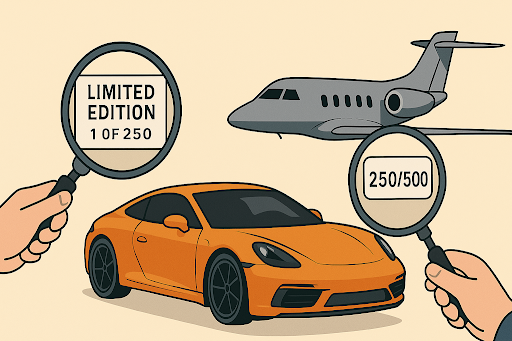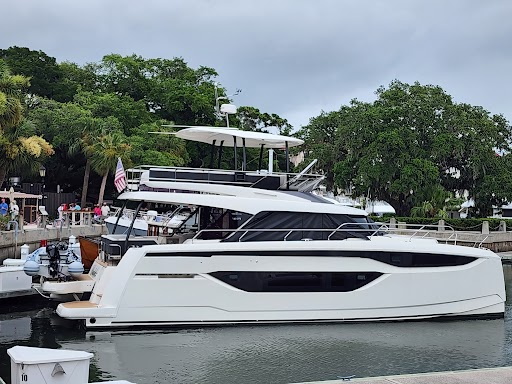
For many, the word “limited edition” is enough to make them perk up with excitement. Whether it’s a luxury supercar crafted in only ten examples or a meticulously detailed aircraft model, limited editions represent far more than rarity. But spotting a real limited-edition item takes a well-trained eye. It also demands provenance, expert analysis, and often, insider access to records the general public can’t reach.
At WishList Luxury, we ensure that our clients are acquiring legacy pieces. When seven figures are on the line, knowing how to verify the real from the replicated is essential.
1. Look for Numbered Editions
A true limited edition usually carries a clear and verifiable production number. That might mean “#7 of 50” engraved on a chassis plate for a car, or stamped on the base of a aircraft model. This number is your first clue that you’re looking at a real collector’s piece.
If you see a model that simply says “limited edition” without a production number, be cautious. Real limited runs are numbered, so you know exactly how many exist in the world. For example, in high-end aircraft collecting, models from brands like Hobby Master or Gemini Jets often include a printed certificate of authenticity with their production number, which is a must-have.
What to look for:
- Factory documentation: A true limited-edition car or aircraft will come with detailed build sheets and factory certifications that confirm its special designation.
- VIN and Serial Number verification: Limited editions often use sequential or special VINs. For aircraft, tail numbers and maintenance logs are key.
- Manufacturer confirmation: Direct communication or certification from the maker adds irrefutable proof. At WishList Luxury, we confirm this through our OEM partnerships.
2. Check for Discontinued or Retired Production
Another sign of a truly limited-edition model or vehicle is whether it has been retired. A car or aircraft that is no longer produced and never will be tends to become more desirable. Think of the Aston Martin DBS Superleggera Concorde, produced in just 10 examples to mark Concorde’s aviation legacy, or a retired model of a WWII Spitfire from Corgi Aviation Archive.
If production has been permanently halted, especially from a respected manufacturer, it usually signals authenticity. Watch for vehicles or models that are no longer listed on the official manufacturer’s website, and always verify through collector communities or catalogs.
3. Research Special Liveries or Design Features
Limited editions often include unique design cues that celebrate a historical event or highlight a brand’s milestone. These details can be easy to miss if you’re new to collecting, so study the features carefully.
For example, a aircraft might display D-Day invasion stripes or markings from a famous squadron. A limited-edition car might feature paint colors exclusive to that run, as seen with the Audi R8 Green Hell, which proudly wore a Tioman green inspired by the Nürburgring’s nickname.
Details also matter. Interiors, plaques, exterior paint, and commemorative badges, all of these features set apart a true limited edition from a standard model with a fancy name.
4. Inspect the Condition and Packaging
Especially with rare models or collectible cars, condition is everything. Original packaging, certificates, protective foam inserts, even the user manual or accessories, can dramatically affect value and authenticity.
For aircraft models, check for these:
- Original box and sleeve
- Undamaged landing gear or propellers
- No paint chips or missing decals
- An undamaged display stand is included
For vehicles, check:
- Matching VIN plates
- Service records
- Limited-edition plaques intact
- Upholstery and trim unique to the edition
If the item looks too worn or is missing any of these details, its authenticity (and value) may be compromised.

5. Investigate the Manufacturer’s Reputation
There’s a big difference between a genuine limited-run item made by a respected manufacturer and a mass-market replica. Brands with a track record of authentic, low-volume, high-quality releases are more trustworthy.
For aircraft models, this includes:
- Hobby Master
- Corgi Aviation Archive
- InFlight 200
- Gemini Jets
- Century Wings
For vehicles, think:
- Bugatti
- Aston Martin (Q Division)
- Rolls-Royce Coachbuild
- Lamborghini (Ad Personam)
- Bentley Mulliner
If the brand is known for strict quality controls and authentic numbered runs, you can feel more confident about its legitimacy.
6. Understand Historical Significance
A vehicle or aircraft’s history is as important as its specs. You should know:
- Ownership lineage: Who owned it, where it lived, and how it was maintained adds value. For example, a Gulfstream once owned by a royal family has a different weight than a similar model used for corporate charters.
- Service records: These indicate how well the piece has been maintained and whether original specs were preserved.
- Auction or private sale history: Past sales through reputable houses like RM Sotheby’s or Bonhams give extra credibility.
We never present an item without full transparency. Our experts compile a complete dossier on every acquisition, including high-resolution inspections and expert third-party reports.
7. Check the Supporting Documentation
Whether you’re spending a few hundred dollars on a model or millions on a hypercar, you should always see:
- Certificates of authenticity
- Service or restoration records (for vehicles)
- Factory build sheets
- Limited-edition production documentation
Missing documentation is a red flag. For the highest-end collectibles, don’t hesitate to get an independent appraisal or even a verification from the manufacturer.
8. Compare with Known Counterfeits
Unfortunately, fakes are everywhere, and they’re getting better every year. In the age of hyper-accurate replicas and online forums, even seasoned buyers have been fooled by “tribute” builds or copied editions.
Especially, Limited-edition models are targets for counterfeiters looking to exploit untrained collectors.
Get familiar with:
- The official packaging design
- The official model codes or VINs
- Fonts, paint finishes, and markings used by the manufacturer
Recent examples we’ve encountered:
- A “Shelby” Mustang that used all period-correct parts but no actual Shelby provenance.
- A “limited” business jet configuration that turned out to be a retrofit done post-sale with no OEM approval.
We’ve turned down multiple seven-figure deals simply because the trail didn’t add up. Because for our clients, anything less than true doesn’t fly—literally or figuratively.
9. Look for Custom Coachbuilt or Bespoke Features
One of the hallmarks of a truly exclusive limited edition is the possibility of custom, coachbuilt, or bespoke features. For example, take the Rolls-Royce Boat Tail, which only three exist in the world, with completely custom bodywork inspired by luxury yachts. Or Pagani’s Huayra Tricolore, of which only three were made to commemorate the Frecce Tricolori aerobatic team.
With coachbuilt or one-off commissions, you’ll usually see:
- Owner’s design input
- Handmade craftsmanship
- Custom materials
- Bespoke badging
These details practically guarantee you’re handling something no one else has.
To check the authenticity of custom features, we typically look for:
- Original factory customization: If it was part of the vehicle or aircraft’s original build from the factory or an official modification partner, it holds weight.
- Third-party modifications: They might enhance performance or aesthetics, but usually decrease the value in collector circles unless certified or done under manufacturer authorization (e.g., AMG for Mercedes-Benz or Dassault Service Centers for Falcons).
- Matching components: Whether it’s a bespoke interior or a one-off aerodynamic package, all custom elements should be verifiable against manufacturer or service partner records.
This is why our team includes former OEM consultants, luxury aviation engineers, and classic car historians to ensure no detail is missed.
Final Thoughts
At the end of the day, “limited edition” should mean something more than a marketing tagline. A true limited edition is a celebration of history, technology, and artistry. It should come with documented rarity, special features, and craftsmanship you can see and feel.
At WishList Luxury, our mission is to protect your legacy, your investment, and your peace of mind. We vet every source, inspect every detail, and work only with the world’s most trustworthy collectors, restorers, and institutions.
With concierge-level handling from inquiry to delivery, we guarantee only the finest, most verifiable limited-edition assets make it to your hangar or garage.
Contact us today at support@wishlistluxury.com


